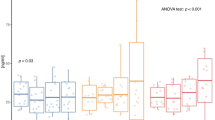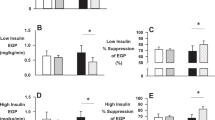Abstract
INTRODUCTION:
Acylation-stimulating protein (ASP) is an adipocyte-derived protein that contributes to fatty acid clearance. Regular exercise training improves fatty acid handling.
OBJECTIVE:
To examine the effect of acute exercise and short-term endurance training on ASP levels.
SUBJECTS:
Eight untrained men (age: 23.5±3.4 y; maximal power output (Wmax): 3.7±0.6 W/kg body weight).
DESIGN:
Subjects were trained for 2 weeks. Before and after training, blood was sampled during a 3-h exercise test, and insulin sensitivity was assessed by an insulin tolerance test.
RESULTS:
Before training, ASP levels decreased during exercise (from 17.9±2.9 to 15.5±3.7 nmol/l at t=0 vs 180, P<0.05). Endurance training decreased fasting ASP levels significantly (17.9±2.9 vs 13.4±2.3 nmol/l pre- and post-training, P<0.001). Interestingly, after 2 weeks of endurance training, ASP levels tended to increase during exercise (from 13.4±2.3 to 17.2±4.5 nmol/l at t=0 vs 180, P=0.09). Baseline ASP levels correlated negatively with insulin sensitivity both before (r=−0.86, P<0.01) and after training (r=−0.82, P<0.05).
CONCLUSION:
Short-term endurance training reduces baseline ASP levels. These data fit with the hypothesis that reduced ASP levels indicate improved ASP sensitivity.
This is a preview of subscription content, access via your institution
Access options
Subscribe to this journal
Receive 12 print issues and online access
$259.00 per year
only $21.58 per issue
Buy this article
- Purchase on Springer Link
- Instant access to full article PDF
Prices may be subject to local taxes which are calculated during checkout



Similar content being viewed by others
References
Yasruel Z, Cianflone K, Sniderman AD, Rosenbloom M, Walsh M, Rodriguez MA . Effect of acylation stimulating protein on the triacylglycerol synthetic pathway of human adipose tissue. Lipids 1991; 26: 495–499.
Cianflone K, Maslowska M, Sniderman AD . Acylation stimulating protein (ASP), an adipocyte autocrine: new directions. Semin Cell Dev Biol 1999; 10: 31–41.
Germinario R, Sniderman AD, Manuel S, Lefebvre SP, Baldo A, Cianflone K . Coordinate regulation of triacylglycerol synthesis and glucose transport by acylation-stimulating protein. Metabolism 1993; 42: 574–580.
Tao Y, Cianflone K, Sniderman AD, Colby-Germinario SP, Germinario RJ . Acylation-stimulating protein (ASP) regulates glucose transport in the rat L6 muscle cell line. Biochim Biophys Acta 1997; 1344: 221–229.
Van Harmelen V, Reynisdottir S, Cianflone K, Degerman E, Hoffstedt J, Nilsell K, Sniderman A, Arner P . Mechanisms involved in the regulation of free fatty acid release from isolated human fat cells by acylation-stimulating protein and insulin. J Biol Chem 1999; 274: 18243–18251.
Cianflone K, Maslowska M . Differentiation-induced production of ASP in human adipocytes. Eur J Clin Invest 1995; 25: 817–825.
Murray I, Sniderman AD, Cianflone K . Mice lacking acylation stimulating protein (ASP) have delayed postprandial triglyceride clearance. J Lipid Res 1999; 40: 1671–1676.
Murray I, Sniderman AD, Havel PJ, Cianflone K . Acylation stimulating protein (ASP) deficiency alters postprandial and adipose tissue metabolism in male mice. J Biol Chem 1999; 274: 36219–36225.
Xia Z, Sniderman AD, Cianflone K . Acylation-stimulating protein (ASP) deficiency induces obesity resistance and increased energy expenditure in ob/ob mice. J Biol Chem 2002; 277: 45874–45879.
Saleh J, Summers LK, Cianflone K, Fielding BA, Sniderman AD, Frayn KN . Coordinated release of acylation-stimulating protein (ASP) and triacylglycerol clearance by human adipose tissue in vivo in the postprandial period. J Lipid Res 1998; 39: 884–891.
Weyer C, Pratley RE . Fasting and postprandial plasma concentrations of acylation-stimulation protein (ASP) in lean and obese Pima Indians compared to Caucasians. Obes Res 1999; 7: 444–452.
Koistinen HA, Vidal H, Karonen SL, Dusserre E, Vallier P, Koivisto VA, Ebeling P . Plasma acylation stimulating protein concentration and subcutaneous adipose tissue C3 mRNA expression in nondiabetic and type 2 diabetic men. Arterioscler Thromb Vasc Biol 2001; 21: 1034–1039.
McGarry JD . Banting lecture 2001: dysregulation of fatty acid metabolism in the etiology of type 2 diabetes. Diabetes 2002; 51: 7–18.
Cianflone K, Zakarian R, Couillard C, Delplanque B, Despres JP, Sniderman AD . Fasting acylation stimulating protein is predictive of postprandial triglyceride clearance. J Lipid Res 2004; 1: 124–131.
Martin III WH, Dalsky GP, Hurley BF, Matthews DE, Bier DM, Hagberg JM, Rogers MA, King DS, Holloszy JO . Effect of endurance training on plasma free fatty acid turnover and oxidation during exercise. Am J Physiol Endocrinol Metab 1993; 265: E708–E714.
Romijn JA, Klein S, Coyle EF, Sidossis LS, Wolfe RR . Strenuous endurance training increases lipolysis and triglyceride–fatty acid cycling at rest. J Appl Physiol 1993; 75: 108–113.
Horowitz JF, Klein S . Lipid metabolism during endurance exercise. Am J Clin Nutr 2000; 72: 558S–563S.
Schrauwen P, Van Aggel-Leijssen DP, Hul G, Wagenmakers AJ, Vidal H, Saris WH, Van Baak MA . The effect of a 3-month low-intensity endurance training program on fat oxidation and acetyl-CoA carboxylase-2 expression. Diabetes 2002; 51: 2220–2226.
Winder WW, Hickson RC, Hagberg JM, Ehsani AA, McLane JA . Training-induced changes in hormonal and metabolic responses to submaximal exercise. J Appl Physiol 1979; 46: 766–771.
Loy SF, Conlee RK, Winder WW, Nelson AG, Arnall DA, Fisher AG . Effects of 24-hour fast on cycling endurance time at two different intensities. J Appl Physiol 1986; 61: 654–659.
Knapik JJ, Meredith CN, Jones BH, Suek L, Young VR, Evans WJ . Influence of fasting on carbohydrate and fat metabolism during rest and exercise in men. J Appl Physiol 1988; 64: 1923–1929.
Coggan AR, Kohrt WM, Spina RJ, Bier DM, Holloszy JO . Endurance training decreases plasma glucose turnover and oxidation during moderate-intensity exercise in men. J Appl Physiol 1990; 68: 990–996.
Wolfe RR, Klein S, Carraro F, Weber JM . Role of triglyceride–fatty acid cycle in controlling fat metabolism in humans during and after exercise. Am J Physiol 1990; 258: E382–E389.
Schrauwen-Hinderling VB, Schrauwen P, Hesselink MK, Van Engelshoven JM, Nicolay K, Saris WH, Kessels AG, Kooi ME . The increase in intramyocellular lipid content is a very early response to training. J Clin Endocrinol Metab 2003; 88: 1610–1616.
Harris JA, Benedict FG, A biometric study of basal metabolism in man. (1919). A biometric study of basal metabolism in man. Washington, Carnegie Institution of Washington.
Kuipers H, Saris WHM, Brouns F, Keizer HA, ten Bosch C . Glycogen synthesis during exercise and rest with carbohydrate feeding in males and females. Int J Sports Med 1989; 10: S63–S67.
Péronnet F, Masssicotte D . Table of nonprotein respiratory quotient: an update. Can J Sport Sci 1991; 16: 23–29.
Borghouts LB, Backx K, Mensink MF, Keizer HA . Effect of training intensity on insulin sensitivity as evaluated by insulin tolerance test. Eur J Appl Physiol Occup Physiol 1999; 80: 461–466.
Maslowska M, Vu H, Phelis S, Sniderman AD, Rhode BM, Blank D, Cianflone K . Plasma acylation stimulating protein, adipsin and lipids in non-obese and obese populations. Eur J Clin Invest 1999; 29: 679–686.
Cianflone K, Kalant D, Marliss EB, Gougeon R, Sniderman AD . Response of plasma ASP to a prolonged fast. Int J Obes Relat Metab Disord 1995; 19: 604–609.
Cianflone KM, Maslowska MH, Sniderman AD . Impaired response of fibroblasts from patients with hyperapobetalipoproteinemia to acylation-stimulating protein. J Clin Invest 1990; 85: 722–730.
Zhang XJ, Cianflone K, Genest J, Sniderman AD . Plasma acylation stimulating protein (ASP) as a predictor of impaired cellular biological response to ASP in patients with hyperapoB. Eur J Clin Invest 1998; 28: 730–739.
Schrauwen-Hinderling VB, van Loon LJ, Koopman R, Nicolay K, Saris WH, Kooi ME . Intramyocellular lipid content is increased after exercise in nonexercising human skeletal muscle. J Appl Physiol 2003; 95: 2328–2332.
Cox JH, Cortright RN, Dohm GL, Houmard JA . Effect of aging on response to exercise training in humans: skeletal muscle GLUT-4 and insulin sensitivity. J Appl Physiol 1999; 86: 2019–2025.
Houmard JA, Shaw CD, Hickey MS, Tanner CJ . Effect of short-term exercise training on insulin-stimulated PI 3-kinase activity in human skeletal muscle. Am J Physiol 1999; 277: E1055–E1060.
Youngren JF, Keen S, Kulp JL, Tanner CJ, Houmard JA, Goldfine ID . Enhanced muscle insulin receptor autophosphorylation with short-term aerobic exercise training. Am J Physiol Endocrinol Metab 2001; 280: E528–E533.
Ahren B, Havel PJ, Pacini G, Cianflone K . Acylation stimulating protein stimulates insulin secretion. Int J Obes Relat Metab Disord 2003; 27: 1037–1043.
Romijn JA, Coyle EF, Sidossis LS, Gastaldelli A, Horowitz JF, Endert E, Wolfe RR . Regulation of endogenous fat and carbohydrate metabolism in relation to exercise intensity and duration. Am J Physiol Endocrinol Metab 1993; 265: E380–E391.
Acknowledgements
We thank Steven Constants and Niels Boon for their help in performing this study. The research of P Schrauwen has been made possible by a fellowship of the Royal Netherlands Academy of Arts and Sciences. This project was made possible by support from CIHR (MOP-13716) to KC. KC is supported by a fellowship from FRSQ.
Author information
Authors and Affiliations
Corresponding author
Rights and permissions
About this article
Cite this article
Schrauwen, P., Hesselink, M., Jain, M. et al. Acylation-stimulating protein: effect of acute exercise and endurance training. Int J Obes 29, 632–638 (2005). https://doi.org/10.1038/sj.ijo.0802949
Received:
Revised:
Accepted:
Published:
Issue Date:
DOI: https://doi.org/10.1038/sj.ijo.0802949
Keywords
This article is cited by
-
Serum Adipsin Levels throughout Normal Pregnancy and Preeclampsia
Scientific Reports (2016)
-
Effect of moderate alcohol consumption on adipokines and insulin sensitivity in lean and overweight men: a diet intervention study
European Journal of Clinical Nutrition (2008)



